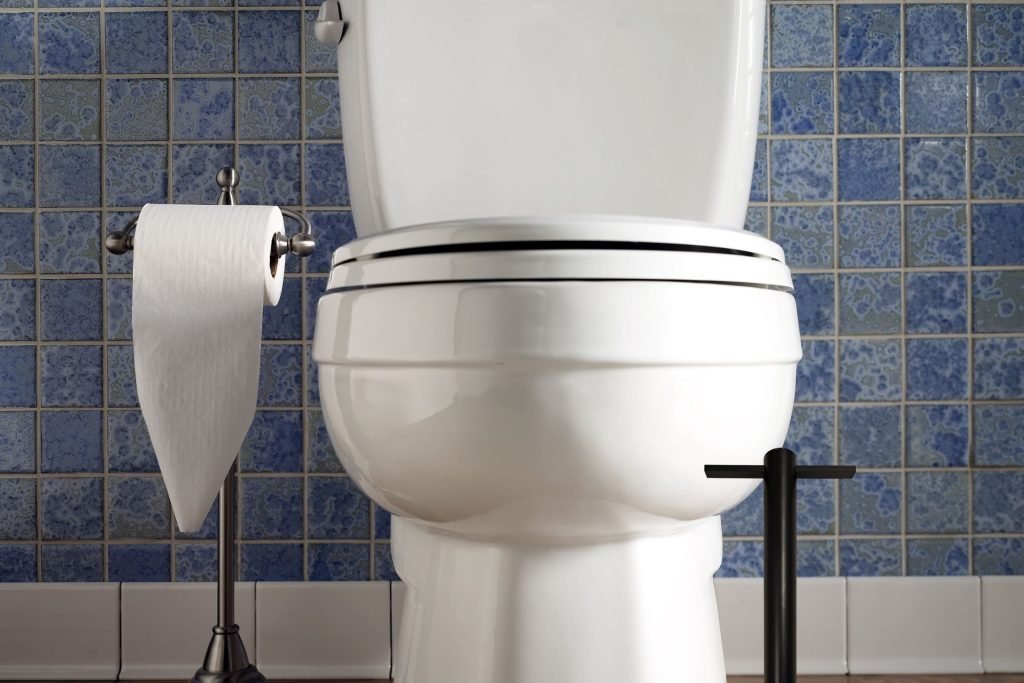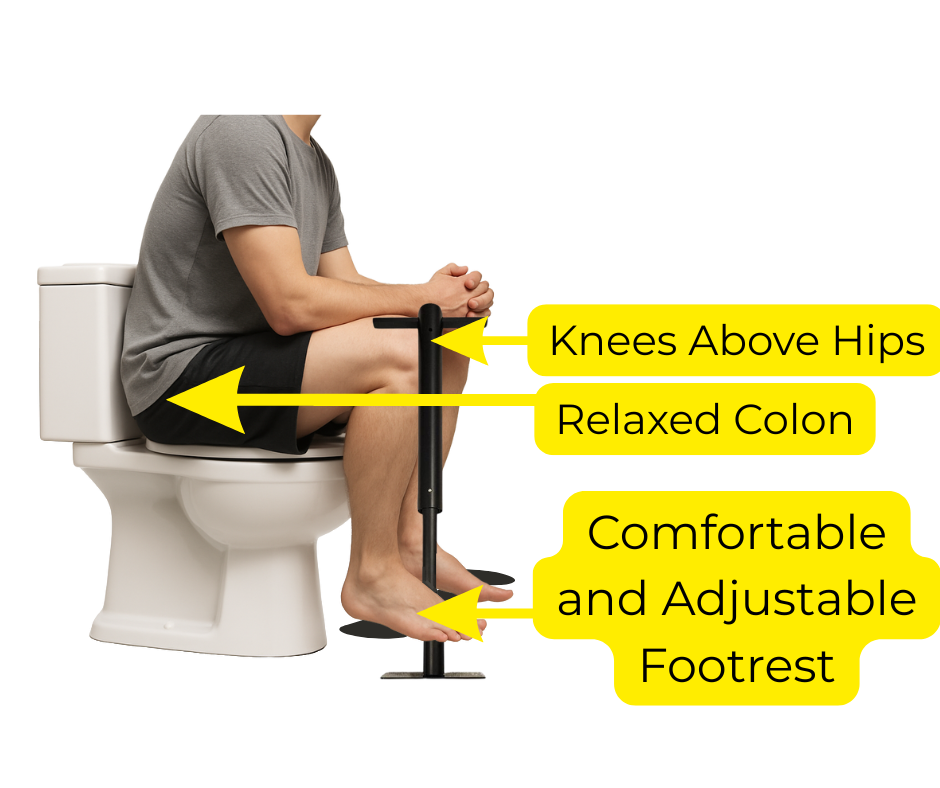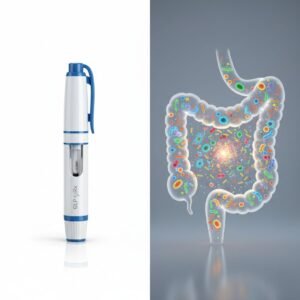Why GLP-1 Drugs Cause Constipation—And How to Fix It Fast
Table of Contents
The Miracle Drug No One Warned You About
Tanya was finally winning.
After struggling for years with her weight—yo-yo dieting, calorie-counting, bouncing from keto to juice cleanses—she finally felt hope. Her doctor prescribed a GLP-1 drug. Ozempic. The same drug her coworkers were whispering about in the break room. The same drug making headlines and disappearing off pharmacy shelves. Within a month, the results were obvious: Tanya’s appetite shrank, her energy spiked, and the scale finally started to budge in the right direction.
But something else started happening, too. Something she wasn’t prepared for. She stopped pooping. Not “a little backed up.” We’re talking three, four, even five days of nothing. She felt bloated, sluggish, heavy—and embarrassed. “Is this normal?” she asked online. The floodgates opened. Hundreds of replies. Same problem. Same frustration.
This wasn’t a side effect. It was a full-on crisis.
If you’re taking a GLP-1 medication like Ozempic, Wegovy, Mounjaro, or Rybelsus—and you’ve found yourself suddenly and severely constipated—you are not alone. The good news? You don’t need to suffer in silence. You just need to understand what’s really going on inside your body… and how to fix it. Naturally. Predictably. Daily.
TL;DR
GLP-1 drugs like Ozempic are powerful tools for weight loss and blood sugar control, but they come with a major hidden side effect: severe constipation. These medications dramatically slow down digestion, which leads to hard, infrequent, and often painful bowel movements. Over-the-counter fixes like laxatives, fiber, and hydration often fall short because they ignore the root problem—mechanics. Your body’s elimination posture is crucial to overcoming GLP-1-related constipation. That’s where The PoopSTICK comes in. This simple device helps you poop naturally by aligning your colon and relaxing the muscles that block smooth bowel movements. If you’re constipated on GLP-1 meds, The PoopSTICK could be your easiest, safest, and smartest fix.
Key Takeaways
GLP-1 medications slow digestion as part of their mechanism, which is great for weight loss but terrible for bowel movements. The food you eat sticks around longer, hardens, and becomes difficult to pass—leading to chronic constipation.
Constipation on GLP-1 drugs is not “normal constipation.” It’s more intense, more stubborn, and more dangerous if not addressed properly. Over-the-counter solutions often make it worse, not better.
Squatting is the body’s natural position for elimination, and modern toilets force your body into an unnatural angle that strains the rectum and blocks flow. GLP-1 users—who already face slow gut movement—are especially vulnerable to this problem.
The PoopSTICK offers a mechanical, drug-free solution that restores your body’s natural posture, helping you go more easily, more completely, and more often—without adding new medications or risky laxatives into the mix.
Real users are already seeing relief by combining The PoopSTICK with smart hydration, movement, and timing rituals tailored to GLP-1-related digestion delays.

What Are GLP-1 Drugs and How Do They Work?
If you’re on a GLP-1 medication—or considering one—it’s time to understand exactly what’s happening inside your body. Because here’s the truth: these aren’t magic shots. They’re biochemical manipulators, and they come with side effects that aren’t just footnotes in the fine print. They hit your digestion where it hurts.
GLP-1 stands for Glucagon-Like Peptide-1, a hormone your body naturally produces after eating. Its job? To signal satiety (that “I’m full” feeling), slow down how fast food leaves your stomach, and help your pancreas release insulin to keep blood sugar in check. Drug companies looked at this natural hormone and said, “What if we cranked the dial to 11?”
Enter: synthetic GLP-1 receptor agonists like Ozempic (semaglutide), Wegovy, Mounjaro (tirzepatide), and Rybelsus. These are not light touch-ups to your biology. These drugs hijack your satiety and digestion systems in a full-court press.
They work by slowing down gastric emptying—which sounds harmless until you realize this means the food you eat can sit in your stomach and intestines twice as long as normal. That’s great for keeping you full and suppressing your appetite, but there’s a dark side: your colon wasn’t designed for this kind of backup.
Your digestive tract is a factory line. Food moves through in stages—grind, digest, absorb, eliminate. GLP-1 drugs gum up the gears. They lengthen the time food stays in the stomach. They reduce the strength of the gut’s muscle contractions. And they dull the signaling pathways that tell your body, “Hey, it’s time to poop.”
In medical terms, this is called gastroparesis—but in real-world terms? You just feel bloated, slow, and stuck. What used to be a once-a-day, effortless routine becomes a war of attrition with your own intestines. And here’s the kicker: this is not a side effect. This is how the drug works. Constipation isn’t a fluke. It’s the price of admission.
But let’s not stop at the theory. Let’s talk about what this means for real people, in real bathrooms, staring down real toilet bowls… and waiting.
The Gut Fallout: How GLP-1 Causes Digestive Distress
Let’s rip the Band-Aid off. The number one reported digestive complaint from GLP-1 users isn’t just occasional nausea or an upset stomach. It’s constipation—painful, persistent, paralyzing constipation. If you’re one of the many now wondering why it feels like your bowels have gone on strike, you’re not imagining things. And you’re not alone.
In fact, clinical studies show that up to 30–40% of patients on GLP-1 drugs experience moderate to severe constipation. And that number is likely underreported. Why? Because most people don’t want to talk about poop. They suffer in silence, writing it off as “normal” or “just a side effect.” But it’s not normal when your body refuses to do something it’s designed to do daily. It’s not “just a side effect” when your digestion grinds to a halt and leaves you bloated, distended, and borderline immobile.
Here’s what’s really happening:
Your food is sitting in your gut longer.
GLP-1s slow down stomach emptying to suppress appetite. But when food lingers, it starts to ferment, dry out, and harden. By the time it reaches the colon, it’s like trying to pass a brick.Peristalsis—the wave-like muscle movement that moves food—is weakened.
Your gut becomes sluggish. It’s not pushing things through like it used to. This isn’t your fault. It’s chemical interference.The nerves that tell you “time to go” are getting silenced.
GLP-1s alter the signaling between your gut and brain. The urge to poop is dulled, delayed, or completely ignored by the nervous system.The rectum starts to malfunction.
With hardened stool and weak pressure behind it, your rectum becomes a storage unit instead of an exit ramp. Over time, this can lead to impaction, hemorrhoids, or worse—a total loss of sensation known as rectal hyposensitivity.
And here’s what the drug companies won’t tell you: the longer you’re constipated, the harder it is to reverse. Not just physically, but behaviorally. Your body adapts to not going. It adjusts to the dysfunction. And then the problem becomes your new normal.
But don’t make the mistake of thinking this is just like “regular” constipation. The kind you get after travel, or when you don’t drink enough water, or eat too much cheese. GLP-1 constipation is a different beast.
It’s mechanical.
It’s neurological.
And it’s chronic.
Now let’s take it a step further—what happens when you try to fix it using the same old over-the-counter tricks?
Spoiler: It usually backfires.
Why Constipation on GLP-1s Is Worse Than “Regular” Constipation
There’s a dangerous lie floating around in doctors’ offices, drug commercials, and online forums. It goes like this:
“Yeah, the meds can cause some constipation… just drink more water, eat fiber, maybe try a stool softener.”
Let me be blunt: this advice is worthless when it comes to GLP-1-induced constipation. It’s like bringing a foam sword to a machine gun fight.
Because this isn’t garden-variety constipation. It’s not a random, occasional inconvenience caused by too much cheese or too little salad. It’s not the “oops, I skipped veggies for a few days” kind of backup. This is deep dysfunction, engineered at the hormonal level and reinforced every day you take that next dose.
When your gut is operating at 50% speed—and your stomach is holding onto food twice as long—your colon doesn’t know what hit it. Now you’ve got stool that’s drier, harder, heavier, and moving through a pipeline with no pressure behind it. No muscular contractions to push. No neurological cues to trigger the urge. Just silence, weight, and distention.
So you do what anyone would do. You Google. You reach for the Dulcolax. You start chugging fiber drinks like a retiree in Boca. And what happens?
You feel worse.
Fiber without motility? It bloats you. It swells inside your stagnant gut and sits there like a ticking gas bomb.
Laxatives? They either do nothing, or they shock your system into a panicked dump that leaves you cramping, dehydrated, and back at square one the next day.
Hydration? Important, yes. But water alone can’t break through a system whose mechanics have been chemically disabled.
And let’s talk about the emotional toll for a moment—because that’s real too.
You’re doing everything “right.” You’re eating less, moving more, injecting your miracle drug, and watching the scale drop. But meanwhile, you’re afraid to leave the house because you haven’t pooped in four days. You feel ten pounds heavier. You’re moody, foggy, and your stomach looks like a third-trimester pregnancy.
You didn’t sign up for this. You thought this was going to be your breakthrough. And now you’re constipated, frustrated, and embarrassed.
But you’re not crazy. You’re not failing.
You’re constipated because your entire elimination system has been hijacked.
And unless you do something to fix the mechanics, not just the chemistry, this won’t magically get better.
But there’s a way out. And it doesn’t require another pill, another supplement, or another $400 pharmacy run.
Let’s talk about squatting—your body’s original blueprint for pooping.

The Secret Weapon: The Squatting Position
Let’s step back 10,000 years.
Long before we invented toilets, bidets, soft-close lids, and triple-ply Charmin, humans squatted to eliminate waste. It was instinctive. Natural. Automatic. When it was time to go, you dropped into a deep squat—knees bent, heels down, hips low—and let gravity and anatomy do the work.
There was no straining. No pushing. No clenching. Just efficient, smooth, full evacuation.
Fast forward to the modern world and we’ve engineered that instinct out of existence. Our sleek, seated toilets force our bodies into a 90-degree sitting position, which feels civilized… but is biologically dysfunctional.
Here’s the problem: in the sitting position, the puborectalis muscle—a sling-like band that wraps around the rectum—stays tight. It kinks your colon like a bent garden hose. Even if you “feel the urge,” your body is in the wrong position to release.
But when you squat? Everything changes.
The puborectalis muscle relaxes.
The rectum straightens.
Abdominal pressure increases naturally.
Your bowels empty faster, more completely, and with less effort.
This isn’t pseudoscience. It’s been validated in peer-reviewed studies, observed on radiographic imaging, and acknowledged by progressive gastroenterologists worldwide. Squatting reduces time on the toilet, straining, incomplete elimination, and even symptoms of hemorrhoids and IBS.
Now combine this with a GLP-1-compromised digestive system, and the need becomes urgent.
If your digestion is slow…
If your signals are muted…
If your stool is dry and hard and refusing to move…
You need every mechanical advantage you can get.
You need to unlock the natural squatting position—but without ripping out your toilet and building a hole in the backyard.
That’s where The PoopSTICK comes in.


How The PoopSTICK Makes Squatting Simple, Safe, and Stylish
This is where the game changes.
If GLP-1s are the chemical culprit behind your digestive slowdown, The PoopSTICK is the mechanical fix that makes your bathroom great again.
Let’s get one thing straight: this isn’t some gimmicky plastic step stool from the back of a daytime TV commercial. This is deliberate, precision-engineered relief designed for real people with real digestive challenges—especially those on GLP-1 drugs.
The PoopSTICK reclaims the squatting position your body was built for—but adapts it to your modern bathroom. You don’t have to rip out your toilet. You don’t have to hang your knees over your sink. You don’t have to balance awkwardly like a circus act just to poop like a caveman.
With The PoopSTICK, you just sit… place your feet… and go.
Here’s how it works:
The PoopSTICK gently elevates your feet, lifting your knees above your hips and tilting your pelvis forward. This automatically straightens your rectum and releases the puborectalis muscle without conscious effort. The “hose kink” is gone. The pathway is open. And your body, even on GLP-1 drugs, can finally let go.
But this is more than a physical shift. This is a return to what works—a way to reclaim your daily rhythm, your comfort, your dignity, and your health.
You’d be shocked how many GLP-1 users feel immediate relief just from adjusting posture alone. What they thought was a gut problem was really a geometry problem. What they blamed on Ozempic was partially caused by decades of sitting in the wrong position.
And with The PoopSTICK, the solution becomes simple. Easy to use. Easy to clean. Easy to hide or display. Built to last. Built to work.
You didn’t sign up for constipation when you started your weight loss journey. And you don’t need to keep suffering when the fix is this simple.
Real Talk: What Users Are Saying
Let’s cut through the clinical studies and brand promises for a minute.
Here’s what actual people on GLP-1 drugs are saying after using The PoopSTICK:
“I was on Mounjaro for four months and nothing worked—fiber, laxatives, enemas. I bought The PoopSTICK out of desperation and the next morning, it was like someone hit the ‘flush’ button on my colon.” — Vanessa H., San Antonio, TX
“Ozempic helped me lose 37 pounds… but made me feel stuck every day. I didn’t think a footstool would fix it. It did. I use The PoopSTICK every morning now and haven’t had a problem in weeks.” — Derrick M., Chicago, IL
“My GI specialist literally told me, ‘Get something to elevate your legs when you poop.’ Found The PoopSTICK on Instagram. I went from going once every 5 days to daily.” — Lauren J., Portland, OR
These aren’t staged testimonials. These are real, unfiltered experiences from real users who got real results.
And here’s the common theme:
They tried everything else.
They were ready to give up.
Then they changed their posture—and everything changed.
You don’t need to suffer another week, another dose, another bloated day. The fix is right in front of you—and it takes 10 seconds to use.
The Poop Plan: A 3-Step Relief Routine for GLP-1 Users
Look, you’re already injecting yourself with a hormone that alters how your gut works. The least you can do is support your body with a simple, natural, non-invasive plan to get things moving again.
Here’s how to reset your rhythm:
Step 1: Prime Your Gut with Smart Hydration
Start each morning with a warm glass of water—ideally with minerals or lemon. Not ice-cold. Not coffee-first. Your digestive tract needs a gentle wake-up, not a caffeine slap. This helps soften stool and activate gut motility from the top down.
Want bonus points? Add magnesium citrate or magnesium glycinate before bed the night before (check with your doctor, but this is a favorite among functional medicine pros).
Step 2: Assume the Throne—The Right Way
This is where The PoopSTICK does the heavy lifting (literally). After hydrating, set yourself up on the toilet with your knees elevated using The PoopSTICK. Sit, breathe, relax. No pushing. No straining. Let gravity and posture do the job.
This position sends a powerful signal to your rectum: “It’s go time.”
Step 3: Activate the Gut Physically
Light movement—just a 5-minute walk, twist, or bounce on a mini-trampoline—can trigger the peristaltic wave your GLP-1-drugged gut is missing. You don’t need a full workout. You just need to stimulate the physical side of digestion.
This 3-step ritual is simple. Drug-free. Repeatable. And it supports what your body already wants to do: eliminate waste. Efficiently. Daily. Naturally.
Final Take: You Shouldn’t Have to Choose Between Weight Loss and Pooping
GLP-1 drugs like Ozempic and Wegovy are revolutionizing weight loss, blood sugar control, and metabolic health. That’s a fact. They’re powerful tools for people who have struggled for decades.
But that power comes at a cost—especially for your gut.
And the truth is, most people weren’t warned. They weren’t told their digestion would slow to a crawl. They weren’t told their bowels might revolt. They weren’t told that the hardest part of the journey wouldn’t be the injections—it would be the constipation that follows.
But now you know.
Now you understand the cause.
And now you have a real, effective, drug-free way to fix it.
You don’t need to keep loading up on laxatives.
You don’t need to keep pretending that drinking more water is enough.
You don’t need to be the person who dreads the bathroom.
You just need to change the position. You just need to unlock the natural mechanics of elimination.
The PoopSTICK isn’t just a stool. It’s a return to what works.
It’s an exit strategy for your constipation crisis.
And if you’re on GLP-1 meds… it’s the smartest investment you can make in your daily comfort and health.

Join our Email List
About the Author

James
Founder of The PoopSTICK | Gut Health Advocate | Healthcare Pro
I’m James, the guy who talks about poop so you don’t have to (but probably should). With over 12 years of experience in the healthcare world—and a family history of colon cancer which made gut health personal—I created The PoopSTICK to give people a better, more natural way to poop.
After trying almost every pooping gadget, toilet stool, and gut health trend under the sun, I realized most products were uncomfortable, overhyped, or just plain awkward. So I built something better—designed for real humans who want real results.
The PoopSTICK isn’t just a product; it’s part of a movement to take gut health seriously (while still laughing a little). Through our blog, I share natural health tips, poop-positive education, and easy ways to take control of your digestion—because better bowel movements should be a normal part of life, not an embarrassing mystery.
If you're someone who cares about health, wants to feel better naturally, or just wants to poop like a champion, you're in the right place.
Let’s talk sh*t—so you can get rid of it better.

James
Founder of The PoopSTICK | Gut Health Advocate | Healthcare Pro
I’m James, healthcare veteran and gut health advocate on a mission to help you poop better—naturally. With over 12 years in the industry and a personal drive to prevent colon cancer, I created The PoopSTICK after being let down by every “solution” out there.
This isn’t just a stick—it’s a movement (literally). I mix humor, health tips, and real talk to make better bowel movements something we can actually talk about.
Let’s ease your poop!
Past Blog Posts

What Your Stool Color & Shape Reveal About Your Gut Health
Your poop is a real-time report card on your gut health—and most people are ignoring it. From color changes to weird shapes to the clues hidden in texture, every bowel movement tells a story. This guide breaks down exactly what your stool says about digestion, inflammation, and the hidden issues you can’t see.

Is Wheat Wrecking Your Gut? What Celiac Disease Reveals
Wheat isn’t the villain—it’s the kind of wheat that’s wrecking your gut. From ancient grains to modern hybrids, discover how today’s wheat triggers inflammation, worsens celiac symptoms, and sabotages digestion—and what smarter, safer alternatives can finally bring your gut back to balance.

Gut Health and GLP-1: The Hidden Link to Weight and Energy
Your gut isn’t just digesting food—it’s controlling your hunger, energy, and even how fast you burn fat. Inside you is a powerful hormone called GLP-1, and when your gut’s out of balance, it shuts down. Discover how to reactivate this hidden fat-burning axis naturally—no drugs, no gimmicks, just real gut power.

